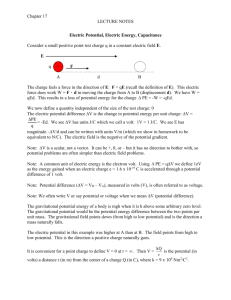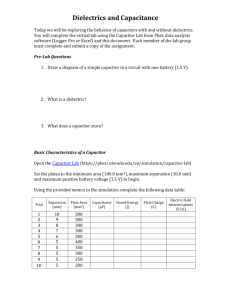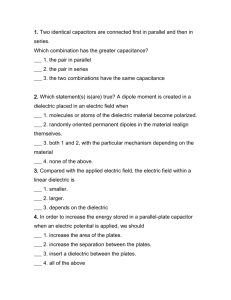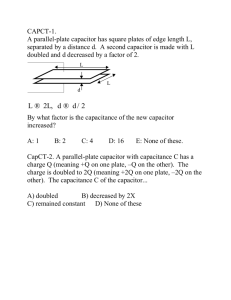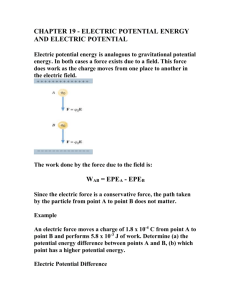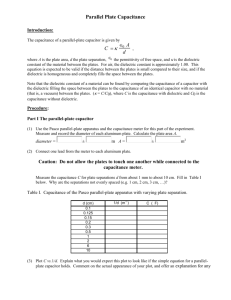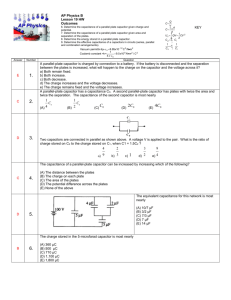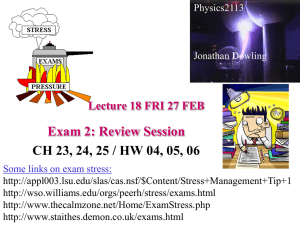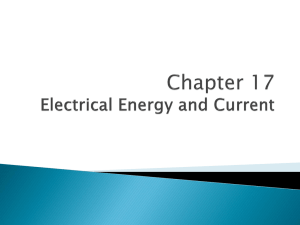chapter16
advertisement
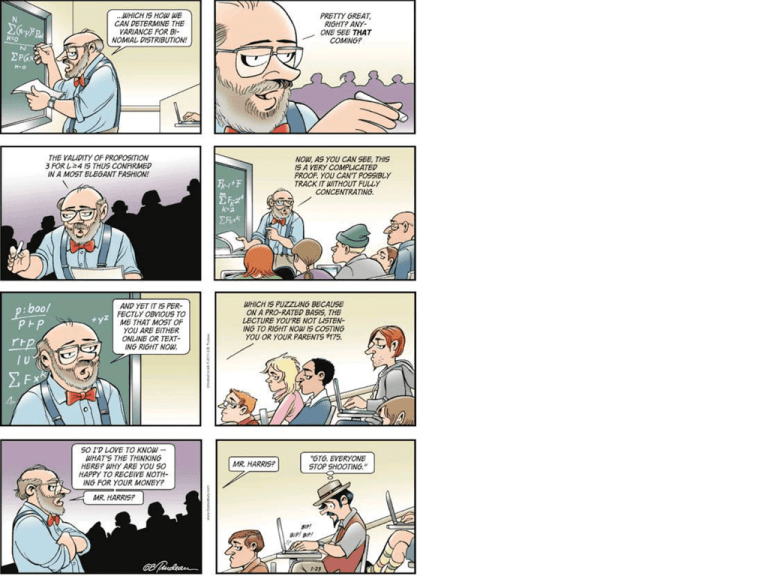
Summary • More circuits • Forces between plates of a capacitor • Dielectrics • Energy and the distinction about constant Q or V. C1 = 5μF, C2 = 10 μF, C3 = 2 μF Calculate the equi. Capacitance. a) b) c) d) 6 μF 2 μF 4 μF 8 μF a. Find the equivalent capacitance between points a and b. b. What fraction of the total energy is stored in the 7 µF capacitor , if the circuit has been charged by a 12 volt battery? a. 12.92 µF b. 46% C1 = C3 = 8.00 μF, C2 = C4 = 6.00 μF, V = 12V When the switch S is closed, how much charge flows through point P C123 2.4 µF, q = 28.8 µC C2 C24 = 12 µF C1234 = 3 µF q =36 µC Δq = 7.2 µC Question • A parallel-plate capacitor has a plate area of 0.3m2 and a plate separation of 0.1mm. If the charge on each plate has a magnitude of 5x10-6 C then the force exerted by one plate on the other has a magnitude of about: • A. 0 B. 5N E. 9 x 105 N C. 9N D. 1 x104 N Question • A parallel-plate capacitor has a plate area of 0.3m2 and a plate separation of 0.1mm. If the charge on each plate has a magnitude of 5x10-6 C then the force exerted by one plate on the other has a magnitude of about: A. 0 B. 5N C. 0. 9N D. 1 x104 N E. 9 x 105 N F qE q 2 2 o A 5 10 6 2 8 . 85 10 2 12 0 .3 4 . 71 N The electric field = σ/2εo why? C oA/d C C air C ap acitor w ith a d ielectric q -q In 1837 M ichael Faraday investigated w ha t happens to the V capacitance C of a capacitor w hen the gap betw een the plates is com pletely filled w ith an insulator (a.k.a. dielectri c) Faraday discovered that the new capacita nce is given by : q' V -q' C C air H ere C air is the capacitance before the insertion of the dielectric betw een the plates. T he factor is know n as the dielectric co nstant of the m aterial. Faraday's experim ent can be carried out in tw o w ays: q V In this case a battery rem ains connected to the plates . -q q -q 1. W ith the voltage V across the plates rem aining constant T his is show n in fig.a V' 2. W ith the charge q of the plates rem ainin g constant. In this case the plates are isolated fro m the battery T his is show n in fig.b (25 - 15) C C air q -q V F ig .a : C a p a cito r v o lta g e V rem a in s co n sta n t T h is is b acau se th e b attery rem ain s co n n ected to th e p lates A fter th e d ielectric is in serted b etw een th e cap acito r p lates th e p late ch arg e ch an g es fro m q t o q q q' V -q' q T h e n ew cap acitan ce C q V V κq κ V q V κ C a ir F ig.b : C ap acitor ch arge q rem ain s con stan t T his is bacause the plates are isolated -q A fter the dielectric is inserted betw een the capacitor plates q -q V' the plate voltage changes from V to V T he ne w capa citance C q V q V / V q V C air (25 - 16) C o A 2d 1 2 If the areas are A1 and A-A1. C o d A 2 A1 ( 1 2 Effect of a dielectric : C κC C123 2.4 µF, q = 28.8 µC C2 C24 = 12 µF C1234 = 3 µF q =36 µC The force on a filling dielectric as it is inserted between the parallel plates of a capacitor. C C1 C 2 dC C dx o x A 1 1 d L L 1 L With the battery connected, U1 = ½CV2 F x dU 1 U 1 1 With the battery disconnected, U2 = Q2/2C F dU 2 U2 1 dx L dx L With the battery connected, since x is increasing downwards, a negative force is upwards, pushing the dielectric away. With the battery disconnected, the force is positive and pointed downwards, pulling in the dielectric. The force is proportional to (κ-1) and inversely to L. To make the argument simple, we have omitted the fact that the field at the end includes the fringe field which depends on distance between the plates. The result including fringe fields is quantitatively different. See S. Margulies, American Journal of Physics, V. 52, p 515 (1984) A question What is the equivalent capacitance between the points A and B? A. B. C. D. E. 1 μF 2 μF 4 μF 10μF None of these A B What would a 10V battery do, i.e. how much charge will it provide, when it is connected across A and B? 40 μC (20 μC) on 2 μF HITT A parallel-plate capacitor has a plate area of 0.2m2 and a plate separation of 0.1 mm. To obtain an electric field of 2.0 x 106 V/m between the plates, the magnitude of the charge on each plate should be: A. 8.9 x 10-7 C B. 1.8 x 10-6 C C. 3.5 x 10-6 C D. 7.1 x 10-6 C E. 1.4 x 10-5 C M ore com p lex cap acitor sy stem s In general a capacitor system m ay consist of sm aller capacitor groups that can be identified as connected "in parallel" or "in series" In the exam ple of the figure C 1 and C 2 in fig.a are connected in parallel. T hey can be substituted by the equivalen t capacitor C 12 C 1 C 2 as show n in fig.b. C ap acitors C 12 and C 3 in fig.b are c onnected in series . T hey can be substituted by a single capa citor C 123 as show n in fig.c C 123 is given by the equation: (25 - 12) 1 C 123 1 C 12 1 C3 All C’s are 8.00 nF. The battery is 12 V. What is the equivalent capacitance? C12 = 4 nF C123 = 12 nF Q123 = C123 x V = 144 nC Q3 = C3 x V = 96 nC Q12 = C12 x V = 48 nC U123 = ½ C123V2 = ½ x 12x10-9 x122 = 864 nJ U1 = ½ C1V12 = ½ x 8x10-9 x62 = 144 nJ = U2 U3 = ½ x 8x10-9 x122 = 576 nF C3 stores most energy, also the highest electric field and most charge, the most stressed part of the circuit. • Series combinations reduce the capacitance. Equal C reduce by the number involved. • In parallel the capacitance increases. A basket of 4 capacitors, each of C = 6 nF. How can you arrange them to get a) 1.5 nF b) 2 nF g) 2.4 nF c) 3 nF h) 3.6 nF d) 4 nF i) 4.5 nF j) 6 nF e) 12 nF k) 18 nF f) 24 nF clicker All C’s are 8.00 nF. The battery is 12 V. What is the equivalent capacitance? a. b. c. d. e. 4 nF 6 nF 8 nF 10 nF 12 nF Circuits • All capacitors being the same, rank the equivalent capacitances of the four circuits. summary C oA/d 2 o L / ln( b / a ) C 4 • Capacitance • Parallel plates, coaxial cables, Earth • Series and parallel combinations • Energy in a capacitor • Dielectrics • Dielectric strength ab o b a 4 o a b a Q CV 1 C 1 C1 1 .. C2 U C C C C 1 C 2 ... 1 2 CV 2 Q 2 2C A question • Each of the four capacitors shown is 500 μF. The voltmeter reads 1000V. The magnitude of the charge, in coulombs, on each capacitor plate is: A. 0.2 these B. 0.5 C. 20 D. 50 E. none of
